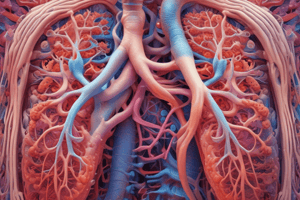Podcast
Questions and Answers
What are the functions of the respiratory system?
What are the functions of the respiratory system?
Gas exchange, Speech, Smell, Helps control pH of body, Aids in regulation of blood pressure, Pressure for flow of lymph fluid and venous blood, Expulsion of abdominal contents.
What is the difference between the structural organization and the functional organization of the respiratory system?
What is the difference between the structural organization and the functional organization of the respiratory system?
Structural organization includes the upper and lower respiratory tract, while functional organization includes the conducting and respiratory zones.
Describe the structure of the mucosa that lines the respiratory tract.
Describe the structure of the mucosa that lines the respiratory tract.
It consists of epithelium resting on a basement membrane and underlying areolar connective tissue.
What are the structural changes of the mucosa observed along its length?
What are the structural changes of the mucosa observed along its length?
Explain the function of mucus produced by the mucosa.
Explain the function of mucus produced by the mucosa.
What is the difference between the conducting and respiratory zones?
What is the difference between the conducting and respiratory zones?
Is the trachea in the upper or lower respiratory tract?
Is the trachea in the upper or lower respiratory tract?
What is sputum?
What is sputum?
Describe the structure and function of the nose.
Describe the structure and function of the nose.
Provide a general description of the structure and function of the nasal cavity.
Provide a general description of the structure and function of the nasal cavity.
Describe the structure and function of the four paired paranasal sinuses.
Describe the structure and function of the four paired paranasal sinuses.
Compare the three regions of the pharynx and describe their associated structures.
Compare the three regions of the pharynx and describe their associated structures.
What are vibrissae?
What are vibrissae?
What is the difference between the lining of the oropharynx and that of the nasopharynx?
What is the difference between the lining of the oropharynx and that of the nasopharynx?
Describe the general functions and structure of the larynx.
Describe the general functions and structure of the larynx.
Study Notes
Functions of the Respiratory System
- Facilitates gas exchange of oxygen and carbon dioxide.
- Enables speech production through airflow and vocal cord manipulation.
- Provides the sense of smell through olfactory receptors.
- Regulates the body's pH by controlling carbon dioxide levels.
- Assists in blood pressure regulation via the angiotensin-converting enzyme.
- Creates pressure gradients that aid lymphatic and venous fluid circulation.
- Helps expel contents from the abdomen during coughing or sneezing.
Structural and Functional Organization
- Upper Respiratory Tract: Comprises the nose, nasal cavity, pharynx, and larynx.
- Lower Respiratory Tract: Includes the trachea, bronchi, bronchioles, lungs, and terminal bronchioles.
- Conducting Zone: Involves all the elements that transport air (nose to terminal bronchiole).
- Respiratory Zone: Comprises structures that facilitate gas exchange (respiratory bronchioles, alveolar ducts, and alveoli).
Structure of Mucosa in the Respiratory Tract
- Comprised of an epithelium and basement membrane, supported by areolar connective tissue.
- Epithelial Changes:
- Pseudostratified ciliated columnar epithelium lines the nasal cavity, pharynx, and trachea.
- Simple ciliated columnar epithelium in segmental bronchi and large bronchioles.
- Simple ciliated cuboidal epithelium in small terminal and respiratory bronchioles.
- Simple squamous epithelium forms alveolar ducts and alveoli.
- Nonkeratinized stratified squamous epithelium lines abrasion-prone areas like the oropharynx.
Function of Mucus
- Functions to trap dust, microorganisms, pollen, and pollutants.
- Contains antibodies and lysozyme, providing antibacterial protection.
Conducting vs. Respiratory Zones
- Conducting zone: Air transport (nose to terminal bronchiole).
- Respiratory zone: Gas exchange (respiratory bronchioles and alveoli).
Location of the Trachea
- Identified as part of the lower respiratory tract.
Definition of Sputum
- Refers to mucus that has been coughed up, similar to a "loogie."
Structure and Function of the Nose
- Structure: Consists of nasal bones, frontal processes, nasal septum, and surrounding structures.
- Function: Key roles in olfaction, respiration, dust filtration, humidification of air, and mucosal secretion management.
Description of the Nasal Cavity
- Structure: Large, air-filled space behind the nose.
- Function: Warms, moisturizes, and filters incoming air before it enters the lungs.
Structure and Function of Paranasal Sinuses
- Comprises ethmoid, sphenoid, maxillary, and frontal sinuses.
- Structure: Air-filled spaces within skull and facial bones.
- Function: Lightens head weight, humidifies and heats air, enhances speech resonance, protects facial structures.
Regions of the Pharynx
- Nasopharynx:
- Located posterior to the nasal cavity; lined with ciliated pseudostratified columnar epithelium.
- Contains auditory tube openings and pharyngeal tonsils (adenoids).
- Oropharynx:
- Positioned posterior to the oral cavity; also lined with ciliated pseudostratified columnar epithelium.
- Houses palatine and lingual tonsils.
- Laryngopharynx:
- Located anterior to the larynx.
Definition of Vibrissae
- Long, stiff hairs on the face, serving as touch-sensitive organs (whiskers).
Differences in Pharyngeal Lining
- Nasopharynx: Lined with pseudostratified columnar epithelium.
- Oropharynx and Laryngopharynx: Lined with stratified squamous epithelium for increased abrasion resistance.
General Functions and Structure of the Larynx
- Functions as an airway passage, prevents food aspiration, and produces sound through vocal cords.
Studying That Suits You
Use AI to generate personalized quizzes and flashcards to suit your learning preferences.
Description
This quiz focuses on the functions of the respiratory system and the distinctions between its structural and functional organization. It is designed to reinforce key concepts related to gas exchange, speech, and various physiological regulations. Test your knowledge with these flashcards from Bio III.




